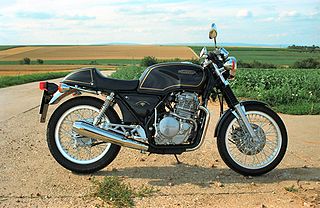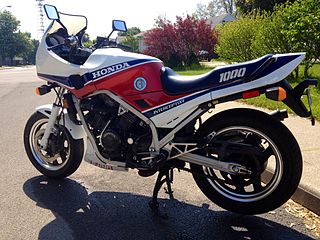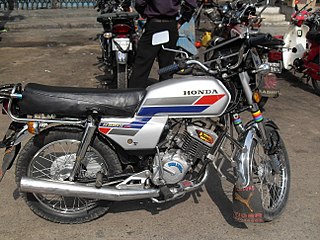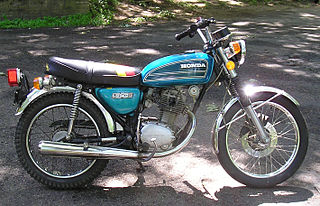
The Honda Magna is a cruiser motorcycle made from 1982 to 1988 and 1994 to 2003 and was the second Honda to use their new V4 engine shared with the VF750S Sabre and a few years later a related engine was fitted to the VF750F 'Intercepter', the later models used a retuned engine from the VFR750F with fins added to the outside of the engine. The engine technology and layout was a descendant of Honda's racing V4 machines, such as the NS750 and NR750. The introduction of this engine on the Magna and the Sabre in 1982, was a milestone in the evolution of motorcycles that would culminate in 1983 with the introduction of the Interceptor V4. The V45's performance is comparable to that of Valkyries and Honda's 1800 cc V-twin cruisers. However, its mix of performance, reliability, and refinement was overshadowed by the more powerful 1,098 cc "V65" Magna in 1983.
The Honda XR series is a range of four-stroke off-road motorcycles that were designed in Japan but assembled all over the world.

The Honda CX series motorcycles, including the GL500 and GL650 Silver Wing variants, were developed and released by Honda in the late 1970s, with production ending in most markets by the mid 1980s. The design included innovative features and technologies that were uncommon or unused at the time such as liquid cooling, electric-only starting, low-maintenance shaft drive, modular wheels, and dual CV-type carburetors that were tuned for reduced emissions. The electronic ignition system was separate from the rest of the electrical system, but the motorcycle could only be started via the start button.

The BSA Bantam is a two-stroke unit construction motorcycle that was produced by the Birmingham Small Arms Company (BSA) from 1948 until 1971. Exact production figures are unknown, but it was over 250,000 and some estimates place the number closer to half a million.

The Honda GB500 'Tourist Trophy' is an air-cooled single-cylinder solo café racer motorcycle. It was first marketed in Japan in 1985 in two 400 cc and one 500 cc versions. In 1989, Honda introduced a third 400 cc version for Japan; and in 1989 and 1990 a 500 cc version was available in the United States.

The VF1000 is a range of motorcycles produced by Honda from 1984 to 1988. The VF1000 is named after its V-4 998 cc (60.9 cu in) double overhead cam 16-valve engine. There were three main models in the VF1000 range, the VF1000F, the VF1000R and the VF1000F2.

The Honda S-MX is a compact MPV produced by Honda, sold between 1996 and 2002.

The Honda CD175 is a 174 cc (10.6 cu in) motorcycle made from 1967 to 1979 by the Honda Motor Company. Described by Honda as a "great new all-rounder, at home around town or putting the highway behind you", it was the touring model in Honda's 175 cc motorcycle lineup that also included the sportier CB175 and the off-road CL175 version. The CD175 shared some components and design elements in common with other models from Honda including the early-model pressed steel backbone frame, sometimes known as "T bone".

The Honda H100S is a two-stroke motorcycle introduced in June 1983, alongside the original Honda H100-A, which was released to the UK in February 1980. The H100-A was built for fulfilling the role of an economical, practical, lightweight commuter machine. It was designed for riders who preferred the simplicity of the two-stroke engine. In Honda style, equipment such as a fully enclosed chain, capacitor discharge electronic ignition (CDI), and a separate oil injection system allowed easy operation of the motorcycle with the minimum of maintenance and attention. The lowly-tuned engine gives adequate performance for use in normal traffic conditions, but does not consume high amounts of fuel. Under normal operating conditions, mileage to the gallon figures regularly exceed 80, often close to 100, impressive for a two-stroke and not far off Honda's own four-stroke commuting machines. The engine uses a reed-valve induction system, and the vibration inherent in single cylinder engines is largely cancelled out by the single shaft primary balancer.

The Harley-Davidson Sportster is a line of motorcycles produced continuously since 1957 by Harley-Davidson. Sportster models are designated in Harley-Davidson's product code by beginning with "XL". In 1952, the predecessors to the Sportster, the Model K Sport and Sport Solo motorcycles, were introduced. These models K, KK, KH, and KHK of 1952 to 1956 had a sidevalve engine, whereas the later XL Sportster models use an overhead valve engine. The first Sportster in 1957 had many of the same details of the KH including the frame, fenders, large gas tank and front suspension.

The Honda CB125 is a 122 cc (7.4 cu in) motorcycle made by Honda from 1971–1985. It had a single-cylinder overhead camshaft (OHC) engine with a 9500 rpm redline. The "S" model was produced from 1971 to 1975 and was replaced in 1976 by the "J" model. The newer model sported a two piece head, 124 cc (7.6 cu in) displacement, and a larger carburettor.

The Honda Ascot was a name given to two motorcycles produced by Honda in the early 1980s. The motorcycles that carried the name, the FT500 and VT500FT, were produced with the Ascot name between 1982 and 1984.
The Honda MR50 Elsinore is an off-road mini cycle made by Honda. It was manufactured in Japan by Honda and imported first to Australia and the United States in 1974 and continued to be available in the United States, Canada and Australia until production was discontinued in 1975.

The Yamaha DT50MX is the most common 50 cc (3.1 cu in) motorcycle in the Yamaha DT series. It superseded the DT50M when introduced in June 1981 and can easily be identified by its Mono-Cross(MX) rear suspension with a silver painted square-section rear swinging arm and a more angular tank as opposed to the more rounded one found on the M variant. The 'MX' designation was commonly used on Yamaha motorcycles fitted with the 'Mono-Cross' rear suspension, which was the first to employ a single shock-absorber. It remained in production largely unchanged until 1996, gaining only a CDI ignition system and a change to square bodied direction indicator lights in 1986 with the introduction of the 2FN model. The moped is very common in Scandinavia where its leading competitor was the Honda MT50 and can be ridden on a CBT at 16 in the UK.
The Honda TMX or Tricycle Model Xtreme series is a line of Business-oriented motorcycles manufactured by Honda for the Philippine market.
One of the short-lived lines of Honda motorcycles is the CJ Series, which was an offshoot of the short-lived CB360. The CJ series motorbikes have inline engines, of a nominal 360cc capacity.

The Kawasaki A1 Samurai is a 250 cc (15 cu in) standard class Kawasaki motorcycle which was sold from 1967 through 1971.

The Honda CB400 Super Four is a CB series 399 cc (24.3 cu in) standard motorcycle produced by Honda at the Kumamoto plant from 1992 to the present. The CB400 embodies the typical Universal Japanese Motorcycle produced through the 1970s, updated with modern technology. To this end, the bike has a naked retro design, paired with a smooth inline-four engine. Originally a Japan-only bike, it was later also available in SE Asia, and from 2008 in Australia.

The Vespa T5 was a 125cc, single cylinder, 2 stroke scooter which was manufactured in the 1985-1999 period by Piaggio.















